
Gamma-ray Burst 000131

On January 31, 2000, 14:59:13 UT, Ulysses, Konus, and NEAR observed a GRB
(BATSE trigger 7975).
(All information courtesy of the instrument teams.)
 Previous IAU Circulars
Previous IAU Circulars
 Results of Observations
Results of Observations
- GCN notice #529
K. Hurley, on behalf of the Ulysses GRB team, and T. Cline and
E. Mazets, on behalf of the KONUS-WIND and NEAR GRB teams, report:
Ulysses, Konus, and NEAR observed a gamma-ray burst on January 31,
2000 at 14:59:13 UT. Its T90 duration was ~50 s and its 25-100
keV fluence was ~10^-5 erg/cm^2. At present, it can only be localized
to two alternate ~55 sq. arcmin. error boxes given by the following
preliminary centers and corners (~3 sigma confidence):
RA(2000) DEC(2000)
ERROR BOX CENTER: 6 h 13 m 32.72 s -51 o 55 ' 36.77 "
ERROR BOX CORNER 1: 6 h 13 m 8.83 s -52 o 2 ' 20.83 "
ERROR BOX CORNER 2: 6 h 13 m 25.43 s -51 o 50 ' 11.43 "
ERROR BOX CORNER 3: 6 h 13 m 40.09 s -52 o 1 ' 1.94 "
ERROR BOX CORNER 4: 6 h 13 m 56.59 s -51 o 48 ' 52.07 "
OR
RA(2000) DEC(2000)
ERROR BOX CENTER: 10 h 48 m 50.99 s 4 o 34 ' 1.70 "
ERROR BOX CORNER 1: 10 h 49 m 21.03 s 4 o 35 ' 42.55 "
ERROR BOX CORNER 2: 10 h 48 m 31.31 s 4 o 36 ' 35.98 "
ERROR BOX CORNER 3: 10 h 49 m 10.65 s 4 o 31 ' 26.95 "
ERROR BOX CORNER 4: 10 h 48 m 20.91 s 4 o 32 ' 19.87 "
There is a fair chance that further processing will allow one
of these positions to be ruled out.
- GCN notice #530
R. M. Kippen (UAH/MSFC) reports on behalf of the BATSE GRB Team:
GRB000131 was detected by BATSE as trigger #7975 at 53877.497 s UT on
2000 January 31. BACODINE/GCN locations were not issued because the
trigger began in a real-time telemetry gap. The burst lasts more than
100 s and is therefore undoubtedly the same event detected by KONUS,
Ulysses and NEAR (GCN 529) some 76 s after the BATSE trigger time
(corresponding to the brightest pulse of the burst). The final BATSE
location is (R.A., Dec. J2000) = (94.0, -52.0 deg), with a total
(statistical + systematic) error radius of 2.3 deg (68% Conf.). This
location rules out one of the two possible IPN error boxes (GCN 529),
which means that the most probable combined BATSE+IPN error-box is:
RA(2000) DEC(2000)
ERROR BOX CENTER: 6 h 13 m 32.72 s -51 o 55 ' 36.77 "
ERROR BOX CORNER 1: 6 h 13 m 8.83 s -52 o 2 ' 20.83 "
ERROR BOX CORNER 2: 6 h 13 m 25.43 s -51 o 50 ' 11.43 "
ERROR BOX CORNER 3: 6 h 13 m 40.09 s -52 o 1 ' 1.94 "
ERROR BOX CORNER 4: 6 h 13 m 56.59 s -51 o 48 ' 52.07 "
The center of this box is within about 0.4 deg of the independent
BATSE location centroid.
- GCN notice #534
H. Pedersen, B.L. Jensen, J. Hjorth, L. Fogh Olsen (U. of Copenhagen),
M.I. Andersen (U. of Oulo), J. Gorosabel (DSRI, Copenhagen),
M. Vestergaard (Ohio State U.), L. Kaper (U. of Amsterdam), and
A.O. Jaunsen (U. of Oslo), on behalf of a European GRB consortium, report:
Using the 8.2-m Antu telescope, Paranal, and the 1.54-m Danish telescope,
La Silla, we have performed optical observations, covering the entire error
box of GRB 000131 (GCN #529, #530), as follows:
Antu:
2000 February 4.04 UT; B, V, R ; 240 s each filter ; FWHM = 0.9"
2000 February 4.22 UT; B, V, R ; 240 s each filter ; FWHM = 0.9"
2000 February 6.10 UT; B, V, R ; 240 s each filter ; FWHM = 1.2"
2000 February 6.22 UT; B, V, R ; 240 s each filter ; FWHM = 1.2"
1.54-m Danish:
2000 February 4.19 UT; I ; 3600 s ; FWHM = 1.3"
For Antu, two separate pointings were obtained using FORS1; the exposure
times apply to each of these. For the 1.54-m, the error box was covered by
a single pointing with DFOSC.
Intercomparison of the Antu images reveals a single, unresolved object, which
has faded significantly between the two observing nights. The variation is
noticed on the V and R exposures, while the B exposures do not show the object
at any epoch. The object is detected in the combined 1.54-m Danish I-band
image.
Its position is RA(J2000) = 6:13:31.0, Dec(J2000) = -51:56:40, with an
uncertainty of about 2".
The object has R ~ 24 in the Feb 4 images and has faded 0.6+-0.1 mag
on Feb 6, corresponding to a power law decay index of -1.2+-0.2.
Sections of the images can be seen at
http://www.astro.ku.dk/~brian_j/grb/grb000131/
jointly with a DSS finding chart.
The R band images are reproduced below:
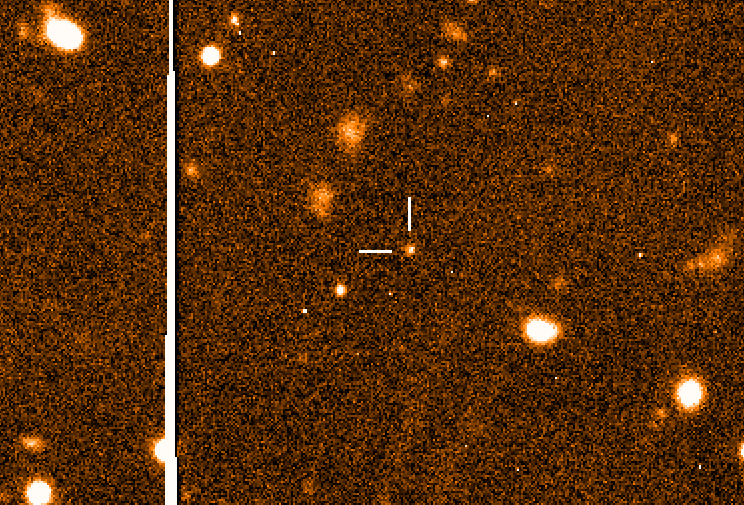
FORS1: 480 s in R, taken 2000 Feb 4.04-4.22.
The spike to the left of the OT is due to a bright (V~9) star to the south.
(North - up, East - left)
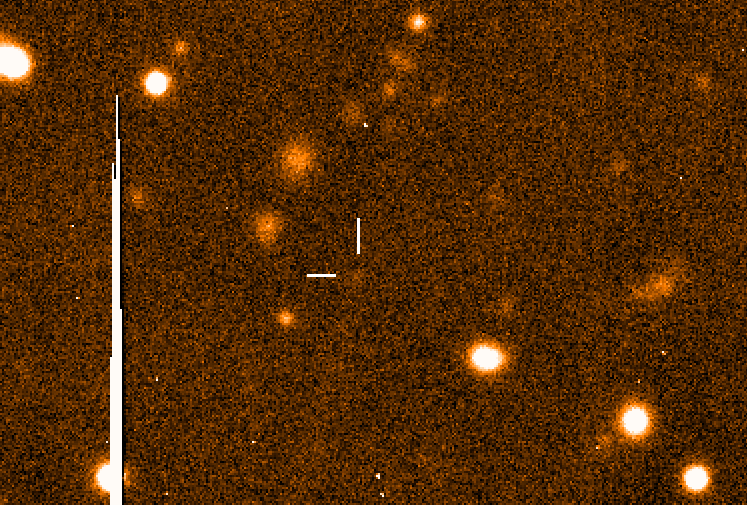
FORS1: 480 s in R, taken 2000 Feb 6.10-6.22.
The spike to the left of the OT is due to a bright (V~9) star to the south.
(North - up, East - left)
- GCN notice #537
S.G. Bhargavi, A.K. Pati, G. SelvaKumar and R. Cowsik
(Indian Institute of Astrophysics, Bangalore, India 560034) report:
We observed the error box of GRB000131 (GCN #529, #530) on Feb 4th and
5th between 15-18UT using the 2.34m as well as 1.02m telescopes of
Vainu Bappu Observatory, Kavalur, India. The sky conditions were
non-photometric with poor transparency and seeing (fwhm >2".5).
The fading optical counterpart reported by Pederson et al ( GCN #534) is
not detected in a single 30min V image (limiting magnitude = 21.0) taken
on Feb 4.68 UT with the 2.34m telescape.
- Redshift measurement
ESO
press release on Oct. 17, 2000
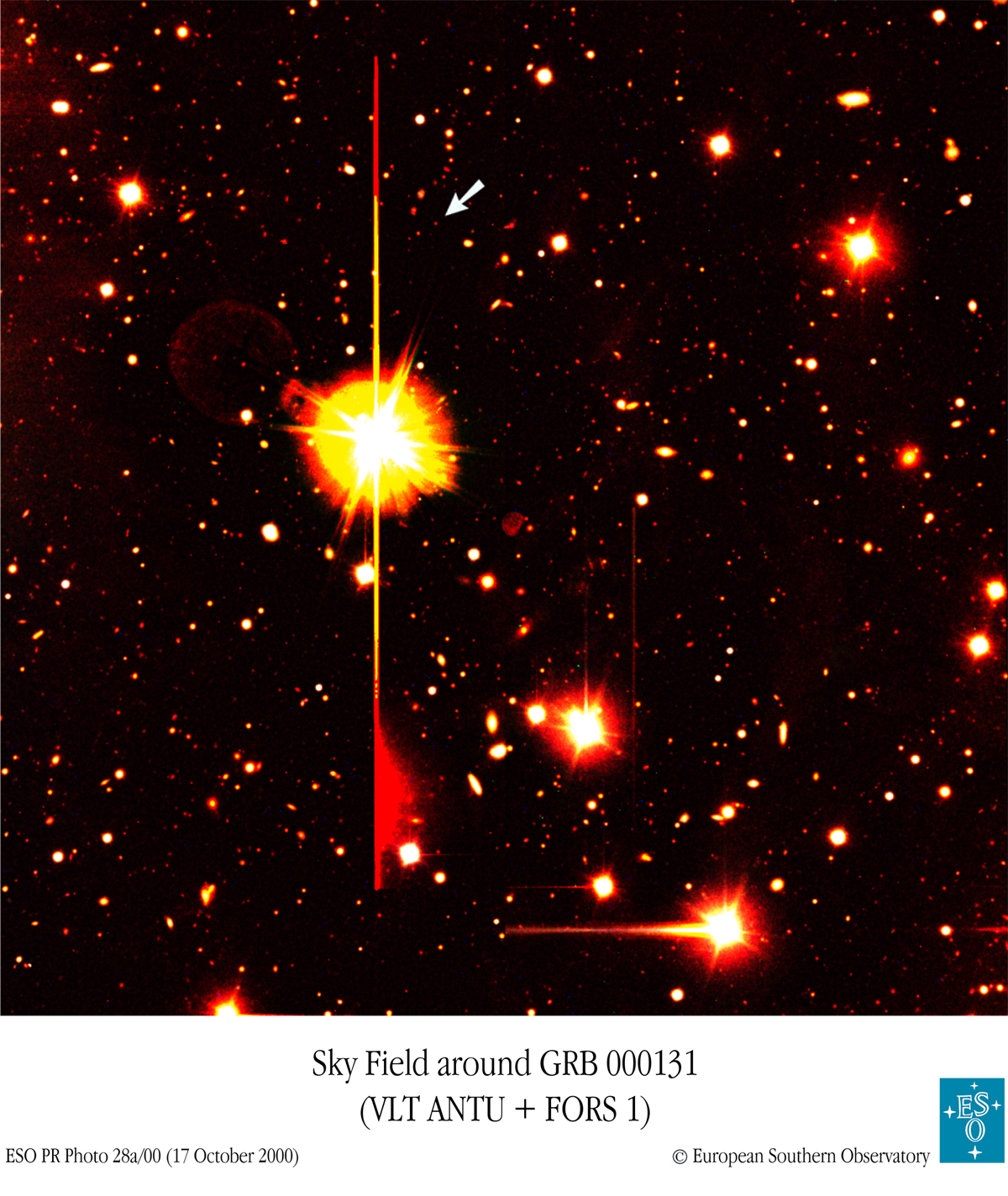
Colour composite image of the sky field around the position of the gamma-ray burst GRB
000131 that was detected on January 31, 2000. It is based on images obtained with the ESO Very Large Telescope at Paranal.
The object is indicated with an arrow, near a rather bright star (magnitude 9, i.e., over 1 million times brighter than the faintest
objects visible on this photo). This and other bright objects in the field are responsible for various unavoidable imaging effects,
caused by optical reflections (ring-shaped "ghost images", e.g. to the left of the brightest star) and detector saturation effects
(horizontal and vertical straight lines and coloured "coronae" at the bright objects, and areas of "bleeding", e.g. below the
bright star).
The photo is based on three 8-min exposures obtained with VLT ANTU and the multi-mode FORS1
instrument. The optical filters were B (seeing 0.9 arcsec; here rendered as blue), V (0.8 arcsec; green) and R (0.7 arcsec; red).
The field measures 6.8 x 6.8 arcmin2. North is up and East is left.
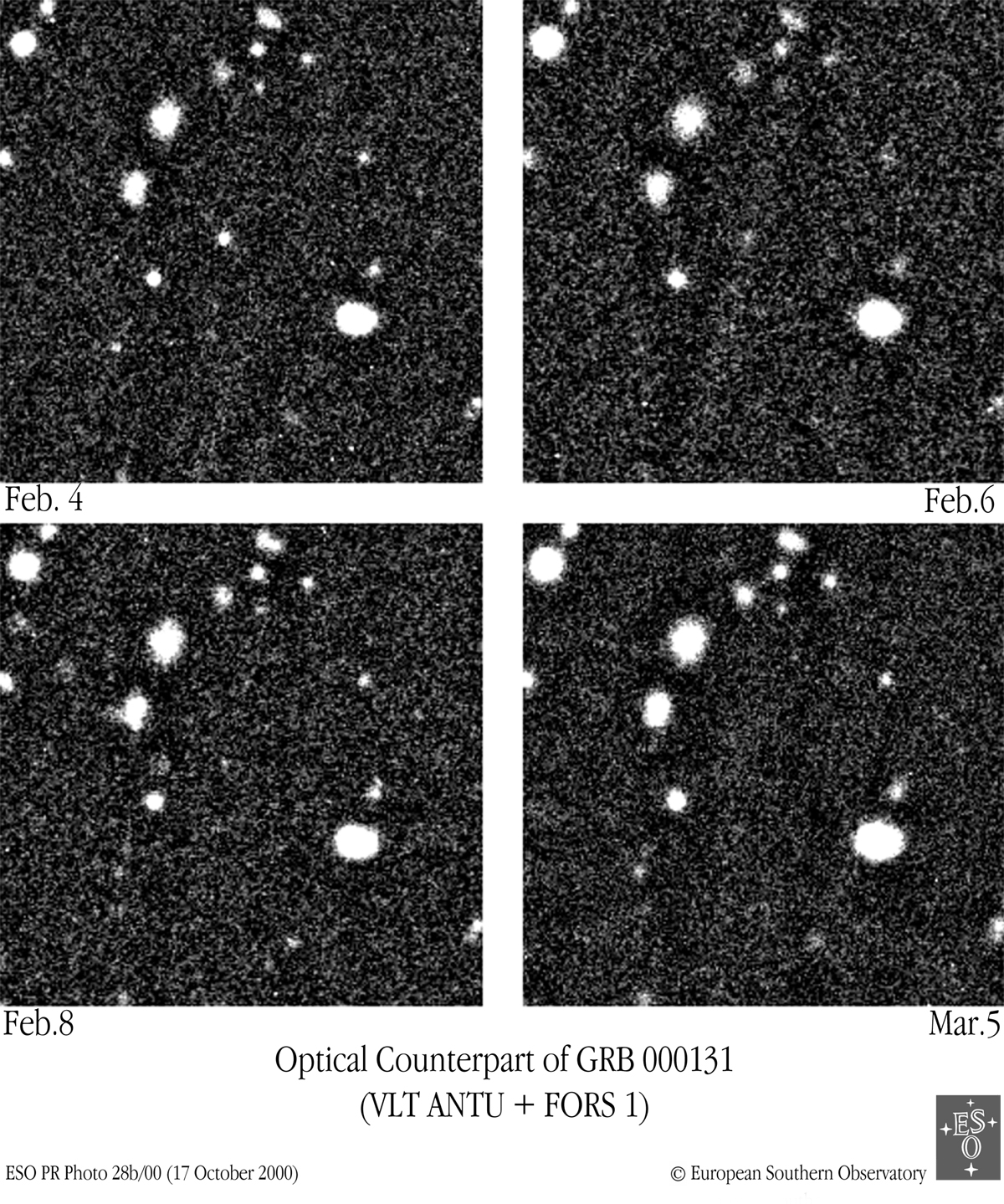
The rapid fading of the optical counterpart of GRB 000131 (slightly left of the centre), by
means of exposures with the VLT on February 4 (upper left), 6 (upper right), 8 (lower left) and March 5 (lower right). It is no
longer visible on the last photo.
The four R-exposures were obtained with VLT ANTU + FORS1 on February 4 (magnitude R = 23.3), 6
(24.4), 8 (25.1) and March 5 (no longer visible). The field measures 48 x 48 arcsec2. North is up and East is left.
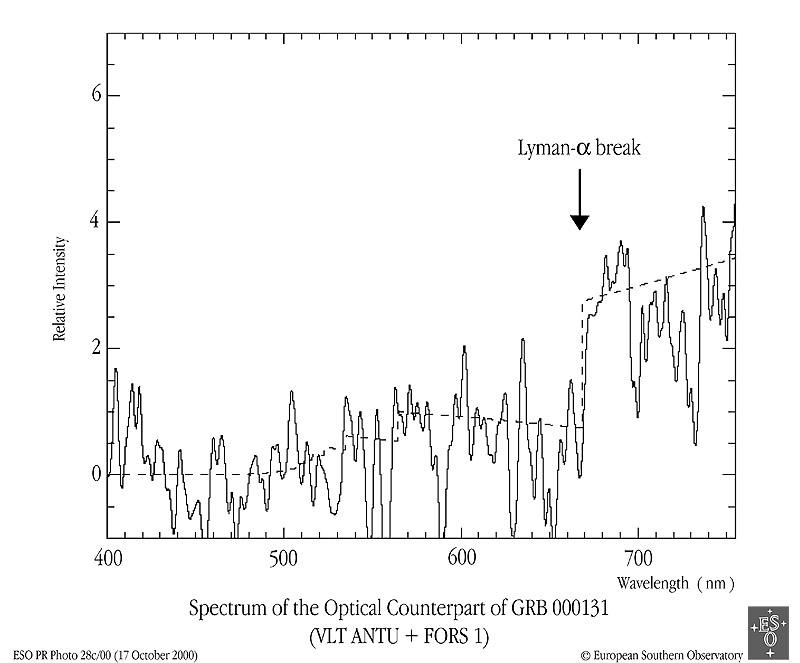
The spectrum of the afterglow of GRB 000131, obtained during a 3-hr exposure
with the FORS1 multi-mode instrument at VLT ANTU on February 8, 2000.
The "Lyman-alpha break" at wavelength 670.1 nm is indicated
The spectrum was obtained during a 3-hr exposure with the FORS1 multi-mode
instrument at VLT ANTU
on February 8, 2000, when the object's magnitude was only R = 25.3. The mean
levels of the spectral continua on either side of
the redshifted "Lyman-alpha break" at wavelength 670.1 nm are indicated.
- GCN notice #1133
GRB 000131: HST Detection of the Host Galaxy
J. S. Bloom, D. Fox, S. R. Kulkarni, T. J. Galama, on behalf the
larger Caltech-NRAO-CARA GRB Collaboration:
"We observed the field of GRB 000131 (Hurley et al., GCN #529; Andersen et
al., 2000, A&A, 364, L54) on 2001 August 17-19 UT using the Hubble Space
Telescope. With a total integration time of 24200 s in the WFPC/F814W
filter, we detect a faint galaxy system coincident with the position of
the optical transient using differential astrometry with the VLT/FORS1
images (GCN #534)."
An image of the field and the putative host system is linked from
http://www.astro.caltech.edu/~jsb/GRB/grb000131
The 3-sigma uncertainty contour of the OT position is shown in this
image.
This message may be cited.
Back to JG's
homepage
Jochen Greiner, last update: 07-Nov-2001
[Disclaimer]
![]() Previous IAU Circulars
Previous IAU Circulars 



